Another month is past with another round of watching wildlife do their thing in my garden.
Or, is it their garden?
It’s a lot about the birds for May, especially those who migrated through Central Texas as they vacated their winter quarters in Mexico and South America and are traveling to their summer breeding grounds–which is pretty much anywhere north of my garden.
I saw this darling ray of sunshine (or perhaps there was more than one??) on a number of occasions, flitting in the shrubbery and bathing in the bog.
This pretty fella is a male Yellow Warbler, Setophaga petechia. What else could he possibly be called?
Texas is on the migratory path of this dazzling fellow and the rest of his kind, but his summer breeding area ranges throughout most of the remainder of North America.
I’m fairly sure I spotted a female Yellow, but never got a good shot of her. Along with bathing alone, he shared a splash with another warbler–both had a good time and were drippy and squeaky clean at the end.
The not Yellow Warbler is either a female or immature male Chestnut-sided Warbler, Setophaga pensylvanica.
I had the hardest time identifying this bird because most bird photos are of males–and why not? The males are typically stunning in color and form and therefore make the most interesting subjects. It was only when perusing the Birds of Texas Facebook group–which I joined not long ago–that someone posted a photo that looked just like my little gal or guy. Yay–a match!
I’m not generally a fan of FB, but it has its uses, that’s for sure.
Actually, I’ve learned quite a bit following these crazy, nutty, obsessive Texas birders–and don’t even get me started on the photos that are submitted–WOW, nothing short of amazing!
Another eye-catching yellow bird that I’ve seen many times before (not this particular bird, mind you, but members of its species) and that I finally captured in photo form, is the Common Yellowthroat, Geothlypis trichas.
I don’t think he’s the least bit common–especially in looks. I love his bandit’s mask, white headband, and bright yellow feathers–he’s a real head-turner. I’ve seen females of this species too, though they’re quick, quick, quick through the greenery as they’re searching for bugs. The females tend to olive-green/with a little pale yellow, but are of the same shape. Another migratory species through Texas, I’m sure this guy and his gal are on their way to northern territories to make more of the same common warblers–good luck to them and their offspring.
In spring 2015, ONE day, I spotted a male Rose-breasted Grosbeak, Pheucticus ludovicianus, visiting my garden. This spring, for several days, a lone female snacked at my sunflower seed feeder.
She’s not as showy as her male counterpart with his brilliant rosy chest, plus she was skittish and good captures were hard to achieve. I hope she has a mate and that she’s on the nest by now–or preparing her nest.
Another bird that I spied last year but didn’t get photos of is the American Redstart, Setophaga ruticilla.
Such a pretty bird! I think this is a female–the males are black, orange, and yellow–but she’s just gorgeous.
She flashed butter-yellow patches on her wings and tail feathers as she darted through the shrubs, on her way to the bog. Later, I saw her again dashing through my Shumard Oak tree which is where I saw others like her last year.
During dinner one evening and while gazing out the big window, I saw this tiny bird angling toward the pond. (That seems a destination of choice for many of the warblers. Good move, putting a pond with a shallow bog in the garden.)
I believe this is a MacGillivray’s Warbler, Geothlypis tolmiei, probably a female.
The light wasn’t optimal and these are the best captures of this bird I could manage. According to Cornell Lab of Ornithology, this bird doesn’t migrate through Central Texas, but in fact, migrates through West Texas, breeding during summer along the West Coast of North America. But none of the other grey/yellow warblers have the exact white eye arcs, nor the hood of gray that extends toward the chest that this cutey displays. The Cornell site on MacGillivray’s (above) mentions that some individual Mourning Warblers can show traits of MacGillivray’s, but I’m going to stick with this ID–unless a reader steers me in another direction.
There were other migrants I saw and heard: an Eastern Wood Peewee one evening at sundown chirping and dancing from a wire to catch insects, and on another day, a Wilson’s Warbler–heading to the pond. Alas, no photos of either. In most cases during migration, the visitors were only here a day or so, then they were gone.
I’m already looking forward to fall migration!
As for the neighborhood birds, there was plenty of action from them as well. My Brazos blackberries were ready for harvesting this past month and certain birds got into the berry-picking action, like this Northern Mockingbird, Mimus polyglottos.
Yeah, I’m lookin’ at you, Mr. Mock!!
I hope you enjoyed those berries, because they’ll never make it into cobbler with you having eaten them!
The resident Black-crested Titmouse, Baeolophus astricristatus, couple are around and singing while raising a small brood.
There was definitely one youngin’ (who flew too close to me one day, surprising both of us, and who probably received a talking-to from mom or dad). Maybe there were more of those titmouse kids?
As well, the Carolina Chickadee, Poecile carolinensis, couple took turns at the feeder and preened in the trees.
I haven’t seen them with offspring, but I hope they raised a family. The world, not to mention my garden, could use more of that cuteness.
And this gangly, awkward teen,
…will someday be as handsome as his dad.
As for the bugs part of this post, Black Swallowtail, Papilio polyxenes, have laid eggs on the fennel,
…and a few caterpillars have eaten their fill.
I haven’t found any chrysalises, but I’ll keep a keen eye out for one; it’s always a treat to observe an adult butterfly as it emerges.
Also nestled in fennel, was this attractive bug, a Spittlebug, Prosapia bicincta.
I didn’t see any of its spittle–which looks like you’d imagine–but I’m certain there was some, somewhere. The spittle covers the nymph stage to provide protection from cold, heat, and predators. These bugs are not friends in the garden as they pierce plants and suck the sap. In most home gardens they don’t cause much damage, but you want to keep tabs on these critters. If I see more than a few, out comes the bucket of soapy water and into the bucket goes the insects–if I can catch them. If I’m feeling especially murderous, squishing said bugs is the modus operandi.
Native and honey bees worked flowers when it wasn’t raining, but I didn’t catch any photos of their activity this month. However, some native bees moved into the second native bee house that Bee Daddy built.
I never figured what species one of belonged to, whose little face and antennae were constantly at an opening for a week or so. Several others, head first in the bee holes (presumably tending to their eggs/larvae), striped abdomens sticking out, are most likely some type of carpenter bee–but I won’t hazard a guess.
I’m just pleased they’re making use of the homes.
Not an insect, this spider has also moved into one of the bamboo pieces of the house.
It might be one of the many kinds of Bold Jumpers, Phidippus, spp. She peeks out often, but if I get too close for a look, she skedaddles back into the bamboo tube.
Finally, The Beast:
There’re more than one of these beasts in my garden (gardener shakes fist at squirrels), but this one charmed as I puttered one afternoon. Pesky and annoying, they’re also smart and adaptable. And funny.
An update about my Eastern Screech Owl family: for the last two evenings, just at sundown, I’ve seen all 5 juveniles and both parents. The family roosts during the day in a large Bur Oak tree, two neighbors away, but fly to my immediate neighbor’s Ash tree at sundown, then follow their parents as the nightly hunting, teaching, and learning begins. The next-door neighbor reported last week that two of the babies bathed in a bird bath outside her bedroom window one morning at about 6:15 am. Apparently, the two little owlets put on quite a show!
Did wildlife visit your garden this past month? Please post for June Wildlife Wednesday Share the rare or mundane, funny or fascinating, beneficial or harmful critters you encounter. When you comment on my post, please remember to leave a link to your Wildlife Wednesday post so readers can enjoy a variety of garden wildlife observations.
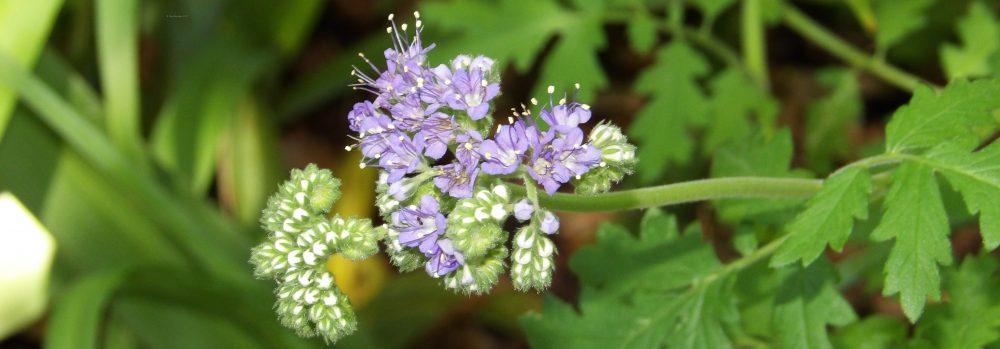
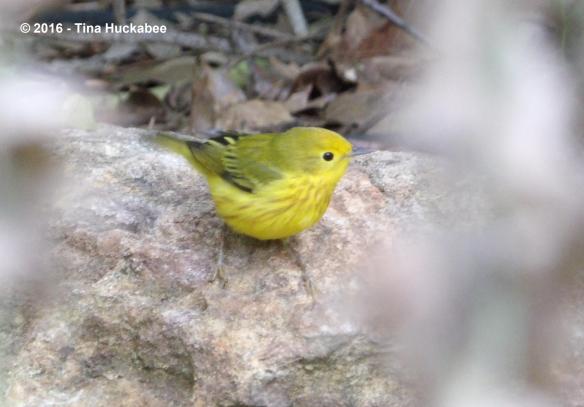








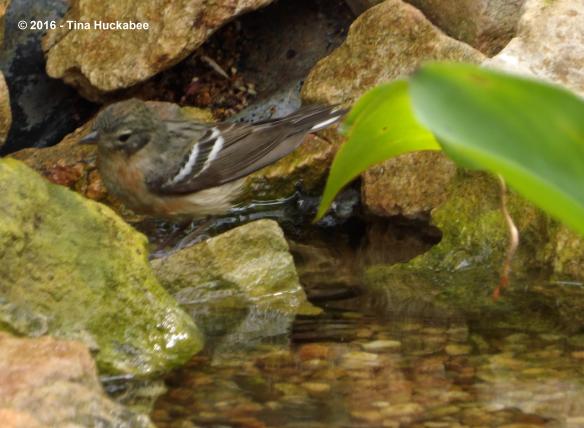










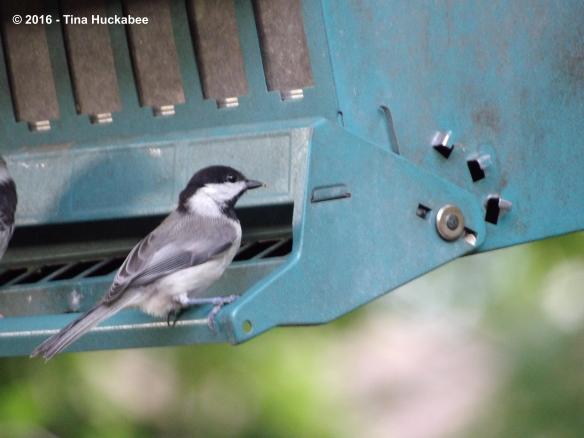


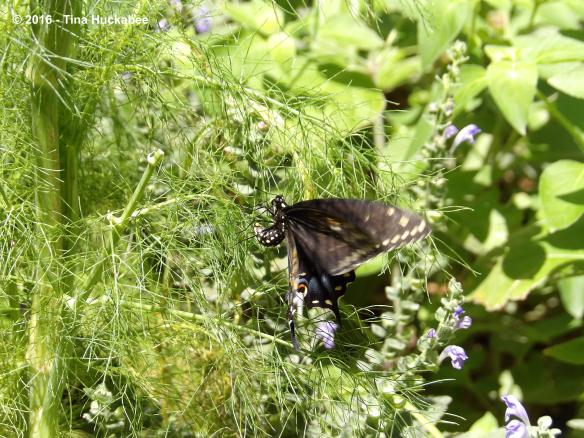






You have had a wonderful assortment of birds passing through. I am impressed that you were able to photograph so many. I heard different voices in the trees, but I can’t always see them.
LikeLike
I feel very fortunate that such a variety came through the garden and that I currently have the time and inclination for identifying them. When they’re up in the trees, it’s tricky to see them, though their songs are a joy!
LikeLiked by 1 person
Your female American Redstart lead me down a rabbit hole to finally identify a mystery bird myself – the female magnolia warbler! Thanks for having such engaging and educational posts.
LikeLike
Aren’t you the lucky girl to have seen a Magnolia!! Congrats!! One of the things I’ve learned to do is to take photos, even if they’re lousy photos, and then compare to Cornell’s, Audubon’s, or the FB Birds of Texas sites. In some cases, the differences (for newbies) is so subtle that it takes a study of a photo to get it right. And, I don’t always get it right. 🙂
LikeLiked by 1 person
When I’m able to get a photo I cheat and send it to my mother 😉
LikeLiked by 1 person
Moms are the best!
LikeLiked by 1 person
Tina, your bird sightings are amazing and all in your own garden. With so many weeds in the garden this spring, I may be looking at the ground too often. In the fall I will look up more and not just assume the birds I hear are the usual visitors.
http://rockoakdeer.blogspot.com/2016/06/wildlife-wednesday-june-2016.html
LikeLiked by 1 person
Thanks, Shirley. It was a treat to watch the birds this spring–I feel really lucky that there was such a variety. Ha–I know what you mean about focusing on the weeds, with all this rain.
LikeLike
Pingback: Wildlife Wednesday – A Perfect Storm | Gardening Jules
Hi Tina, you see so many birds in your garden, I am really glad to read your Owls and Owlets are doing well, did you mind them taking a bath next door, I should have called them back! The Yellow Warbler photos are really lovely and I’m not sure what the male would look like but the female Redstart is very beautiful in her own right. Brazos Blackberries – is that a botanical name? We love a cobbler here too, but not tried one with Blackberries before. I have just been watching a short film on nesting mason bees, with blocks similar to yours, the sides of the case had a removable door with glass panel to see the action inside – I remember you putting yours up and now reminded again that I want to do the same as you with blocks.
Here’s my post, I think things are better for you over there – you’ll see what I mean when you read it, as far as nurseries go in the US.
Thanks for hosting Tina – Happy Wildlife Wednesday to you!
LikeLike
Ha! I must admit that I was a little jealous that the owlets bathed in HER birdbath–what’s wrong with mine??? It was nice seeing them though recently and Mama came to the tree where their brood box is and trilled for a minute or so–I’d like to think she was saying “hi!”. Isn’t the Redstart pretty? The males have similar markings, but with orange and black. I’ve never seen one, but if you click the highlighted link, you can see what they look like. The Brazos blackberries are a cultivated blackberry here in Texas. (The Brazos is one of the rivers in Texas, which btw, is flooding at the moment.) The blackberries are so delicious, but the vine is really thorny–I get lots of cuts during blackberry season, but it’s worth it. I love blackberry cobbler or blue and blackberry cobbler–yum! As for the native bee boxes, I get the impression there are lots of different ways they can be made and the easiest is to simply lay out cut wood from a downed tree and let them have at it. Good luck with putting one up and I hope you take photos and write about it.
LikeLiked by 2 people
Tina wonderful garden, with many migratory birds that pass and make a stop to rest in your garden. And you can photograph them. Congratulations also for the birds that live and breed in your garden. It is magnificent. Greetings from Margarita.
LikeLike
Thank you, Margarita. It was quite fun to observe the birds as they visited, ever so briefly, here in my garden. Thanks for stopping by.
LikeLike
It has been a pleasure to see so beautiful and so well photographed birds. Thank you for your kind of ornithology. Greetings from Margarita.
LikeLiked by 1 person
Thank you, Margarita. I’ve certainly enjoyed seeing and learning about these birds.
LikeLike
Tina I know many of the birds that visit your garden are passing by but at least you can enjoy them for a moment and you have some lovely resident birds too, wonderful photos, pleased to read the owl family is thriving, I love the yellow warbler photos with the soft focus edges, beautiful and what a sweet little bird,
my post is posted, thanks for hosting this wonderful meme, I am learning so much from it, both by spending more time studying wildlife in my garden and reading posts from other wildlife watchers, Frances
LikeLike
Hi Frances! I’m appreciative that the little migrants pop through–even if it’s just for a short time. I hope they’re finding some respite in my garden, considering how far they travel. The Yellow warbler is quite fetching–and so colorful. You’re very welcome–I’ve enjoyed this meme and the preparation for each month’s post. I’ve also learned quite a bit and it’s helped me to become a more observant and intentional gardener.
LikeLiked by 1 person
I loved seeing all your beautiful migratory song birds. I wish we were on their migratory path. We are missing out! We do get Purple Martins, though, and that’s one of the birds featured in my Wildlife Wednesday post:
http://poultrypalaceandgardens.blogspot.com/2016/06/wildlife-wednesday-birds.html
P.S. Your “beast” gave me a good laugh…so ferocious…and cute.
LikeLike
Thanks, Tracy–I’ve loved hosting the song birds in the garden! You’re so lucky to get the Purple Martins. I’ve tried, but we just have too many trees–a good problem to have, but not conducive to Martins. As for the beast, well, he (or she) was just too cute to ignore.
LikeLike
What beautiful birds. Send them over here please. We enjoy the common-or-garden visitors and would like a few of those migrators. You can have our turkey if you like! We do have the white eyed vireo but only hear him. He is too secretive to catch more than a glimpse but I know they are nesting around here.
LikeLike
It’s interesting that you’re not getting many birds as you’re in such an open, less urban area. Hmmmm. I’d love to see your turkey–especially, oh say, in November?? As far as I know, I haven’t had any vireos in my garden, but I know that there are birds, very elusive, who stay in the trees and I never see them. I’m not very good with bird song/calls yet–working on that!
LikeLike
So many birds! And what’s interesting is that we’ve had most of them travel through here in my part of Wisconsin, too. We have Black-Capped Chickadees and Tufted Titmouses. We rarely see Mockingbirds here (although they were fun to watch/here at my parents’ place in Florida). Otherwise, we have most of the other birds in common. Your photos are beautiful. I don’t know if my most recent post qualifies, but it is mostly about wildlife in the garden: https://plantpostings.blogspot.com/2016/05/lessons-in-awe-and-wonder.html.
LikeLike
I’m quite jealous of you northern gardeners who get to watch many of these birds throughout summer. It’s great that they pass through Texas, I just wish they stay a little longer and visit.
LikeLike
Dear Tina: Birds are fascinating to watch, aren’t they? I added another birding/wildlife post today: https://plantpostings.blogspot.com/2016/06/a-hummingbirds-nest.html. Blessings to you for hosting. 🙂
LikeLike
I planted milkweed last year and we have had quite a few monarch butterflies visit this year. A couple weeks ago, my three year old spotted a monarch caterpillar from our dining room window (great observation skills!). It was stuck to the bottom of the leaf of a Turk’s Cap and was in the classic J shape. Within a couple of hours, it had formed a chrysalis. Thanks to Ev, I was able to catch some really great pictures of the process. You can view them on my post here: http://www.amysnativeplants.com/learning-as-i-grow/turks-cap-a-garden-treasure
LikeLike
Hi Amy, thanks for stopping by. It’s absolutely the best thing when parents are teaching their children about the natural world in their plot of the Earth or nearby parks–good for you–and Ev!!
LikeLike
What a wonderful collection of photos- makes me want to set up a pond to attract the migrating birds! Thanks for sharing their info- it’s great to learn about them. I’m glad the owls have done well, too! My wildlife is a bit more local.. http://123thgm.blogspot.com/2016/06/june-already.html
LikeLike
Toni, I really think it is the pond which is the big draw for birds. There are also many mature trees, but the pond, and specifically the bog area, seem to be what they’re most interested in. So, go for it–just make sure you have some shallow area for the little birds.
LikeLike
Pingback: Wildlife Visitors in May | My Wild Australia
Interesting reading and a great collection of photos Tina. I especially love the squirrel, we don’t have them in Australia. He looks cute and cheeky! Here’s my post. https://mywildaustralia.wordpress.com/2016/06/02/wildlife-visitors-in-may/
LikeLike
Hi Sue! Most North American garden have a real love/hate relationship with squirrels–mostly a hate relationship, I think. I don’t mind them and they are cheeky, to be sure!
LikeLiked by 1 person
Well my goodness what beautiful birds…so many warblers. I spotted a male Yellow Warbler the other day. What a stunning little bird. And you have some birds I have heard about but had never seen…loved the Common Yellowthroat.
I am showcasing spring visitors at my blog…here’s the link:
http://www.livingfromhappiness.com/wildlife-lesson-as-spring-unfolds/
LikeLike
I would imagine that some of my brief visitors will spend the summer with you!! I agree that the Yellow and the Common Yellowthroat are lovely birds to observe.
LikeLike
From TexasDeb of http://austinagrodolce.blogspot.com/ who is experiencing technical difficulties: “Your lovely photos and enthusiasm are contagious as always! What a stirring affirmation of the power of water to draw in wildlife. While I’ve left many plants to go to seed this year (which seems to be happening early) I have neglected the feeder and thusly missed a lot of clear sightings of feathered visitors. Consistent rains here (a phrase I never thought I’d be writing about Central Texas after years of drought) have rendered the bird baths less a draw than usual, but water features are clearly a magnet of another order of attraction.
And here’s a hurrah for the Owl Family. Good parenting skills clearly but also the great fortune to have a native plant packed, water featured nesting box haven for their home base. Pat yourselves on the backs as well Mr/Ms My Gardeners! That trilling visit must truly have been a well deserved “thank-you” serenade!”
LikeLike
I’ve enjoyed the bird visitors (especially) and the challenge of watching without scaring, photographing without smearing, identifying with as few mistakes as possible. Right. 🙂
I do think the pond/bog is a huge draw–so glad that we built it, I’ve never regretted that project. Aren’t those Screech Owl parents just the best, ever? I like to think that Mama was saying a cheery ‘hi’ to me and letting me know all is well with her family. That’s certainly how I took the flight to the tree and the nice, long trill.
LikeLike
Thanks for “helping” me comment, Ms Tina. I’ve got “install pond/bog” on my long term “to-do” list!
LikeLike
Oh good heavens, what a gorgeous collection of visitors you’ve photographed and written about! (Though when I saw the Common Yellowthroat, I thought, “oh, it’s a yellow flying raccoon”!!) 😉
LikeLike
Haha! That really would be something, a flying raccoon! No, just little migratory birds. 🙂
LikeLiked by 1 person
What another fantastic collection of pretty little birds you’ve photographed. Can I ask whether you water/pool is static or whether it flows? Glad to hear the screech owl update too.
LikeLike
Thanks–the birds were fun to watch, I just wish they’d hang around longer. The pond has a pump and the water is moved through the bog area and there is a waterfall on the opposite side of the pump. Saw the Screeches last night, too, all 7 of them!
LikeLiked by 1 person
Tina – your post is as lovely and interesting as usual! Quite few new birds for me, among the more familiar.
I’m swamp in seeds and seedlings and admit didn’t take pictures in the garden lately; I shall make it up next month.
LikeLike
I would imagine you do get some of these during the summer as Canada is where many of these darlings breed. No worries about this month, but I always enjoy your posts!
LikeLike
I learn so much from your posts, Tina. (But they make me want to take my cats out and shoot all three of them!) Loved the little yellow warbler you showed first – and wonderful to have an update on the owl family (think I would have been a tad jealous that they bathed in my neighbour’s birdbath also!) I can’t believe that those Texas birders on Facebook take better pictures than yours. Really? Am now seriously thinking of homes for bees, especially after reading Julie’s ‘Perfect Storm’ post this morning. Thanks for such a wonderful ‘wildlife roundup’!
LikeLike
Thanks, Cathy. Domestic cats are a real problem for birds. Here in North America, it’s estimated that 3.7 billion (yes, you read that right: BILLION) birds are killed by cats. Ugh.
Oh, you’d be amazed at the photos that come across from the birders–so beautiful. There are some professional photographers in the group, but many are just interested birders who take great photos. Certainly something to aspire to!
Julie’s post was excellent and the native bee houses are very easy to make and there are lots of ways to encourage native bees, no matter where you live. I look forward to reading about yours!!
LikeLiked by 1 person
The thing that the cats do, which is good, is to keep down the vole population which eats the roots off anything I plant. We always thought that with so many walls and being in the country we did enough for bees, but Julie’s wonderful post has been real food for thought this weekend. As every year goes by, I take more and more pleasure in the bees that visit our flowers. The birds are always too far away for me to catch a glimpse, except for early in the morning before the door is open – as I open it there’s a wonderful rustling noise as they all rush off from wherever they’ve been feeding!
LikeLiked by 1 person
I can imagine that your cats keep the voles in check–that’s a good thing, too! Like you, I’ve become quite enamored with observing and learning about bees–native and honey–and gearing my gardening priorities toward making them welcome. Birds, especially the little song birds, are elusive–and quick!
LikeLike
I love those yellow birds! Those are species we don’t have here although we don have a lot of goldfinches. But I really love that pond. What a cool place for a creature to live. 🙂 I’m a softie for squirrels. They’re just so cute…
LikeLike
I’m with you on the squirrels–I”m quite fond of them and they’ve never been TOO damaging to my garden. The yellow warblers are so pretty–I’m tickled to have finally taken some decent shots of them.
LikeLike
What gorgeous birds! Wow! And that squirrel looks like the devil himself.
LikeLike
He is. Trust me. He is. 🙂
LikeLike
Pingback: Wildlife Visitors In June | My Wild Australia